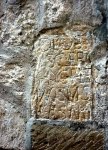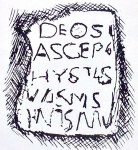OS Grid Reference: SD 61411 73931. In the 15th century parish church of St John the Baptist at Tunstall, near Kirkby Lonsdale, Lancashire, there is a fragment of an inscribed Roman stone, which was perhaps part of an altar but, according to the church guide, is actually a votive stone with a dedication in Latin to two Roman dieties – very roughly carved onto it; the stone was found in the 1800s at the Roman fort of Burrow (CALACVM), a couple of miles to the north. The stone was brought into the church from the churchyard in the early 20th century and was set (upside down) into a window jamb of the north aisle during restoration work. Also of interest within the church is the altar stone which is considered to be Anglian and to date from the 8th century? St John the Baptist’s church can be found along Church Lane about ¼ of a mile to the northeast of the village. The village of Tunstall itself is roughly 3½ miles to the south of Kirby Lonsdale on the A683 and 4 miles southwest of Cowan Bridge.
The Roman votive ‘altar’ stone with its Latin inscription reads: ‘DEOS ASCLEPIO ET HYGIAEAE P S SVA CVM SVIS IVL SATVRNINVS’ and when translated is something like: “To the dieties (gods) Asclepius and Hygiaea, Julius Saturninus placed This Here for himself and his family.” The word ‘SANCTO – Sacred’ can sometimes be placed at the beginning of an inscription like this as another variation.
Sara Mason (1994) in her work concerning the church and parish of Tunstall tells us that “A stone in the present church is dedicated to Aesculepius, the pagan Roman god of medicine and Hygeia, goddess of healing. This was salvaged from the ruins of the Roman fort at Burrow in the eighteenth century by the Reverend Richard Rauthmell. And a fragment of another triangular Roman stone was built into a farmhouse wall in Burrow; a remaining piece was said to be in the keeping of the vicar of Tunstall.”
Mason also adds regarding the: “Fragment of Roman votive stone: this, with a dedication to Aesculepius and Hygeia (god of medicine and goddess of healing) by one Julius Saturninus, was incorporated into the left jamb of the most eastern window of the north aisle during the 1907 restoration of the Church.”
Sara Mason (1994) adds that: “The stone of which the altar in the present church is made is considered to be Anglian (eighth century) and bears evidence of early Christian worship at Tunstall, possibly from when St Wilfred came westwards from Ripon. It was put into its present place in the 1950s. A medieval burial slab was reused and preserved, as a quoin in the old school house in the Church Lane.
The Roman road from Ribchester to Overburrow Fort runs near Tunstall Church and it is possible that an early church was built there because it was close to the road. However, churches, being on consecrated land, rarely change site. The field named Crosber — up the Church Lane, between the Cant beck and the Roman road — may refer as much to the crossing of the Roman Road by the road from Burton in Lonsdale towards the Lune, as to the possibility of a preaching cross there.”
Lawrence E. Jones & Roy Tricker (1992) tell us a bit about the church, saying that: “Visiting a country church like this, in its delightful rural setting, stops people imagining that Lancashire is just industry and suburbia. This lovely church of St John the Baptist was much rebuilt in 1415, but incorporates earlier work, and we enter beneath a fine two-storeyed porch, to admire 15th and 16th century glass from Flanders in the east window and much else in this atmospheric place. The medieval altar stone, cast out at the Reformation, has now been restored to its rightful use.”
Nikolaus Pevsner (1979) describes St John Baptist Church in ‘His’ way, saying that: “The only church in North Lancashire which one can praise for never having given in to sweeping suggestions to restore windows and other features. How right Ruskin and Morris were ! It creates a human appeal which cannot otherwise be roused. The church was rebuilt by Sir Thomas Tunstal about 1415, but the W and E responds of the N arcade have early C13 capitals, and the W lancets of the aisles are probably also C13. On the N side is a two-light Dec window. The two-storeyed porch is the finest piece of the C15 work. The Perp tracery of the S aisle and the Perp arcades are coarse. — FONT. C18 stone baluster with an elliptical marble baluster. — ROMAN ALTAR to Asclepius and Hygieia (NE window sill). — STAINED GLASS. The E window has Nether-landish late C15 and C16 glass from two different sources. It was brought from Flanders by Richard T. North before 1833. — PLATE. Chalice and Paten by Richard Bayley, 1708; Paten by Henry Jay, 1709-10; Chalice inscribed 1713; Paten and Flagon by Thomas Mason, 1718-19. — MONUMENTS. Defaced early C16 stone effigy (S chapel), probably Sir Thomas Tunstal. — Many Tablets, eg. Lt. Miles North, 1837, with the relief of a shipwreck.”
Also of interest: there are several Medieval carved stones leaning against the outside wall of the church, one of which could be a cross-head, but its age is uncertain though it is possibly Anglo-Saxon?
Sources and related websites:-
Jones, Lawrence E. & Tricker, Roy, County Guide To English Churches, Countryside Books, Newbury, Berkshire, 1992.
Mason, Sara, The Church And Parish Of Tunstall, (Drawings by John Cotton), December 1994.
Pevsner, Nikolaus, The Buildings of England — North Lancashire, Penguin Books Ltd., Harmondsworth, Middlesex, England, 1979.
Photo (top) by karl & Ali: http://www.geograph.org.uk/photo/1992950
http://www.megalithic.co.uk/modules.php?op=modload&name=a312&file=index&do=showpic&pid=133149
https://en.wikipedia.org/wiki/St_John_the_Baptist%27s_Church,_Tunstall
https://britishlistedbuildings.co.uk/101071642-church-of-st-john-the-baptist-tunstall#.W4R9w1K0Vjo
http://cumbrianchurches.blogspot.com/2009/08/tunstall-st-john-baptist.html
© Ray Spencer, The Journal Of Antiquities, 2018.


